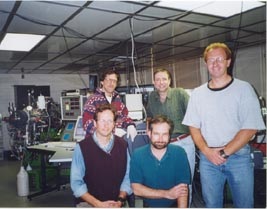Research
Research of extraterrestrial materials, particularly involving meteorites, is commonly called cosmochemistry. UCLA has one of the strongest cosmochemical teams in the world. It includes seven senior cosmochemists and a large amount of sophisticated instrumentation.
Cosmochemists at UCLA use the instrumentation to explore the origin and early history of the Solar System. Our research themes extend from the processes that produced and modified the cloud of dust and gas surrounding the nascent Sun and the mechanisms that formed the first meter- to kilometer- size planetesimals (and ultimately the primitive chondrites) to the processes that affected accreted asteroids, to those that resulted in the accretion of the rocky planets.
The tools we employ to inform our data-driven research include the following state-of-the-art facilities:
- A Cameca ims 1270, the nation�s first high-resolution/high-sensitivity ion microprobe. This machine permits the isotopic study of O, S, Cr and other elements in 10- to 20-μm spots on meteoritic materials.
- A Finnigan Neptune multiple-collector inductively coupled plasma mass spectrometer; the Neptune is capable of both high precision radiogenic or stable isotope analyses with sampling either by in situ laser ablation of 40 to 60 μ spots or of chemically separated samples.
- Two Finnigan gas-source mass spectrometers for small sample stable-isotope analyses by ultra-violet laser ablation or infrared laser heating; these permit high-precision analyses of O and other elements.
- A gamma-ray spectrometry laboratory for instrumental neutron-activation analyses. This technique yields high-precision elemental concentration data for 14 elements in iron meteorites and about thirty elements in stony meteorites.
- A JEOL SuperProbe electron microprobe analyzer with five x-ray spectrometers and a back-scattered electron detector. This is a source of petrological data on stony and stony-iron meteorites, commonly used in combination with isotopic data obtained from other instruments.
- A LEO 1430VP variable pressure scanning electron microscope with an energy-dispersive x-ray analyzer and cathodoluminescence detector.
- Clean room and mineral separation facilities to support the isotope geochemistry laboratories.
- The megaSIMS is a unique, high-sensitivity mass spectrometer that was created by using an ion probe as a source and an accelerator as the mass analyzer. This is the only such instrument in the world; it was used to study O isotopes in samples from the Genesis mission.
- There are several petrographic microscopes that enable researchers to examine meteorite textures in thin section and study the optical properties of mineral grains.

Look at the latest research by UCLA's cosmochemists and asteroid/comet scientists:
- Kevin McKeegan, Professor (Emeritus)
- Amy Mainzer, Professor
- Peng Ni, Assistant Professor
- David Jewitt, Distinguished Professor
- Edward Young, Professor
- Alan Rubin, Research Geochemist
- Paul Warren, Research Geochemist
- Frank Kyte, Research Geochemist (Emeritus)
